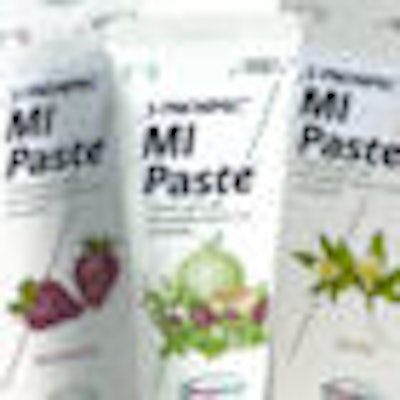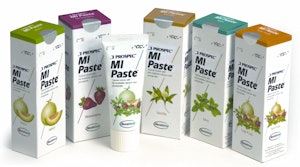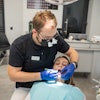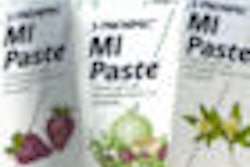
You can get it as a prophy paste or a toothpaste, a gum or a rinse. Nearly a score of calcium phosphate products are jostling for position on store shelves and the hearts of dentists across the U.S. But a growing chorus of researchers says the evidence so far doesn't support the claims.
The biggest red flag, they say, is that most of the studies have been conducted by people with an interest in marketing the products.
Over the summer, calcium phosphate product makers and inventors touted new studies supporting competing formulations of the products. At the annual meeting of the International Association for Dental Research (IADR) in Toronto, NovaMin Technology, in a new partnership with Sultan Healthcare, said its studies show its ReNew Remineralizing and Desensitizing Paste is better than the established MI Paste (also known as Tooth Mousse) marketed by GC America.
 |
| MI Paste by GC America. |
The inventors of MI Paste were on hand to show new evidence for the effectiveness of their product, as were the creators of a formulation backed by the ADA Foundation.
But independent researchers are becoming restless with all these claims. In the Journal of the American Dental Association, scientists from the University of Western Ontario took aim at the science behind MI Paste (JADA, July 2008, Vol. 139:7, pp. 915-924).
The active ingredient, Recaldent, is made of casein phosphopeptide-amorphous calcium phosphate (CPP-ACP). In October 2004, the FDA approved MI Paste as a prescription-only dentifrice for abrasion and polishing, as well as for treating dental sensitivity, postscaling, root planning, and bleaching. In April 2007, it approved MI Paste Plus for the same purposes. The use of these products for preventing dental caries, reducing dry mouth, and remineralizing dentin and enamel is off-label.
For their JADA article, the University of Western Ontario reviewers combed the literature for randomized trials of products containing CPP-ACP, focusing on caries-prevention studies.
They noted that only two of the 10 studies on caries prevention were conducted in people; the other eight were performed in laboratory settings. Furthermore, six of the 10 studies were conducted by the product's inventor, University of Melbourne professor Eric Reynolds, Ph.D., and his collaborators. Not surprisingly, all six sided with CPP-ACP-containing products as being more efficacious than competitors. In contrast, all four of the studies conducted by independent investigators did not show a preponderance of evidence in favor of the CPP-ACP-containing products.
Evidence found lacking
“I would not recommend products containing Recaldent, such as chewing gum or dental products such as MI Paste, at this time.”
— George Stookey, Ph.D.
The reviewers concluded that "there is insufficient clinical trial evidence" to recommend these products. They called for "well-designed and -conducted, double-blind, randomized clinical trials with adequate sample size, limited or no loss to follow-up and carefully standardized methods of measurement and analysis" to show whether or not the products can fight caries.
What do the members of Dr. Reynolds' research team make of this conclusion? Collaborator Stuart Fischman, D.M.D., a professor emeritus at State University of New York at Buffalo, stated this was "a fine review of the literature" in an e-mail to DrBicuspid.com. "Unfortunately, the article was written before the publication of a major clinical study," he noted.
The article that Dr. Fischman is referring to details a study in which 2,720 students at 29 schools chewed either Trident White with CPP-ACP or a placebo gum for at least 10 minutes, three times a day for two years. The researchers assessed standardized digital bitewing radiographs taken at baseline and the end of the trial for proximal surface caries in the enamel and dentine (Caries Research, May 2008, Vol. 42:3, pp. 171-184).
Less than 1% of the subjects in both groups showed signs of caries after one year. But the investigators determined that, relative to the control gum, the Trident White gum resulted in 18% fewer lesions, which was a statistically significant difference.
So does this settle the matter? Not really, according to James Wefel, Ph.D., director of the Dows Institute for Dental Research at the University of Iowa. Dr. Wefel recounted several significant weaknesses in the Caries Research paper.
"The data are troubling in my mind because so few surfaces show any change after two years," he stated in an e-mail to DrBicuspid.com. "I think we may have 'statistical significance' without having 'practical significance' in terms of prevention." He also noted that the study doesn't give actual caries data from clinical exams and that there was a large drop out rate.
Dr. Wefel's conclusion is that "many questions need to be answered to make an evidence-based decision on the use of these products in general."
George Stookey, Ph.D., of the Indiana University Emerging Technologies Center in Indianapolis, agreed. In an e-mail to DrBicuspid.com, he questioned why the Caries Research paper reported only the data on proximal tooth surfaces.
"Our own studies have also failed to demonstrate a benefit from the Recaldent products," he added, citing studies currently in press.
He concluded that there is a need for more independent investigations, and that he would "not recommend products containing Recaldent, such as chewing gum or dental products such as MI Paste, at this time."



















